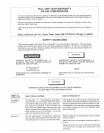
WHATTO
LOOK FOR WHAT COULD HAPPEN NOW TO PREVENT }T
Hot Parts The compressor head and tubes get hot when Never touch the air compressor head or tubes dar-
the air compressor is running. If you touch them, ing or immediately after operation.
you can be seriously burned.
Flammable It is normal for the motor's electrical contacts to Operate the compressor in well ventiIated areas
Vapors spark when the compressor starts or stops. A thatarefreeofgasotine, flammablepaintorsoivent
spark can ignite flammable vapors from vapors.
gasoline, flammable paints or solvents and if spaying a flammable material - provide ample
cause a fire or explosion.
ventilation. Never spray in a closed area. There
must be a flow of fresh ad at alt times.
Compressed Air Compressed air can propel dust, dirt or loose Never point any nozzle or sprayer toward a person
particles it comes in contact with. or any part of the body.
Always wear safety goggles or glasses when using
the air compressor.
Always turn the air compressor off and release air
pressure from hose before attaching or removing
accessories.
Moving
Parts
Toxic 'Vapors
Air Tank
Too much air pressure applied to air tools or
accessories can cause damage or risk of
bursting.
This compressor cycles automatically when the
switch is in the "On-Auto" position. If you
attempt repair or maintenance while the com-
pressor is operating, or with the switch in the
"On-Auto" position, you can expose yourself to
moving parts. These moving parts can cause
serious injury or damage, if they come into con-
tact with you or your clothing.
Check the manufacturer's maximum pressure rat-
ing for air tools and accessories. Regulator outiet
pressure must never exceed the maximum pres-
sure rating.
It is normal for compressed air to contain toxic or
irritating vapors. Such vapors are harmful if
inhaled.
Always unplug the unit and release air pressure
from the tank and any accessories before doing
repair or maintenance.
Never operate the compressor with the belt guard
removed.
Certain materials you are spraying (like paint,
weed killer, sand or insecticide) can be harmfu!
if you inhale them.
Modifications to the air compressor can cause
the air tank to rupture or explode.
Changing the air tank wi!! cause it to weaken.
The tank can rupture or exptode.
Never directly inhale the compressed air produced
by this unit.
Read labels and safety data for all materials you
spray. Follow alI safety precautions.
Use a mask or respirator if there is a chance of
inhating toxic sprayed materials. Masks and
respirators have timits and will only provide protec-
tion against some kinds and limited amounts of
toxic material. Read mask and respirator instruc-
tions carefully. Consult with a safety expert or
industrial hygienist if you are not sure about the use
of a certain mask or respirator.
Do not adjust, remove or tamper with the safety
vatve or pressure switch. If safety valve or pressure
switch replacement is necessary, a part with the
same pressure rating must be used.
For service replacement use only the motors, pul-
leys and belts designed as standard service
replacement parts as indicated in the parts list.
Use of improper parts could cause overloading of
your unit and electrical supply.
Do not substitute a gas engine for the motor.., this
compressor was not designed to be powered by a
gasoline engine.
Never replace the compressor pump with a differ_
ent model
Never increase the compressor pump speed.
Never drilt into, weld, or in any way modify the air
tank. Do not repair a leaking tank, it must be
replaced.
Never replace the air tank with a different model or
a larger tank.
4


















